| Listing 1 - 7 of 7 |
Sort by
|

ISBN: 1282129465 9786612129469 1400826942 9781400826940 0691124604 9780691124605 9781282129467 6612129468 Year: 2006 Publisher: Princeton, N.J. : Princeton University Press,
Abstract | Keywords | Export | Availability | Bookmark
 Loading...
Loading...Choose an application
- Reference Manager
- EndNote
- RefWorks (Direct export to RefWorks)
This book introduces a new class of non-associative algebras related to certain exceptional algebraic groups and their associated buildings. Richard Weiss develops a theory of these "quadrangular algebras" that opens the first purely algebraic approach to the exceptional Moufang quadrangles. These quadrangles include both those that arise as the spherical buildings associated to groups of type E6, E7, and E8 as well as the exotic quadrangles "of type F4" discovered earlier by Weiss. Based on their relationship to exceptional algebraic groups, quadrangular algebras belong in a series together with alternative and Jordan division algebras. Formally, the notion of a quadrangular algebra is derived from the notion of a pseudo-quadratic space (introduced by Jacques Tits in the study of classical groups) over a quaternion division ring. This book contains the complete classification of quadrangular algebras starting from first principles. It also shows how this classification can be made to yield the classification of exceptional Moufang quadrangles as a consequence. The book closes with a chapter on isotopes and the structure group of a quadrangular algebra. Quadrangular Algebras is intended for graduate students of mathematics as well as specialists in buildings, exceptional algebraic groups, and related algebraic structures including Jordan algebras and the algebraic theory of quadratic forms.
Forms, Quadratic. --- Algebra. --- Mathematics --- Mathematical analysis --- Quadratic forms --- Diophantine analysis --- Forms, Binary --- Number theory --- Algebra over a field. --- Algebraic group. --- Associative property. --- Axiom. --- Classical group. --- Clifford algebra. --- Commutator. --- Defective matrix. --- Division algebra. --- Fiber bundle. --- Geometry. --- Isotropic quadratic form. --- Jacques Tits. --- Jordan algebra. --- Moufang. --- Non-associative algebra. --- Polygon. --- Precalculus. --- Projective plane. --- Quadratic form. --- Simple Lie group. --- Subgroup. --- Theorem. --- Vector space.
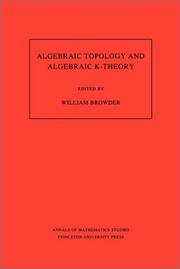
ISBN: 0691084157 0691084262 1400882117 Year: 1987 Publisher: Princeton : Princeton University Press,
Abstract | Keywords | Export | Availability | Bookmark
 Loading...
Loading...Choose an application
- Reference Manager
- EndNote
- RefWorks (Direct export to RefWorks)
This book contains accounts of talks held at a symposium in honorof John C. Moore in October 1983 at Princeton University, The workincludes papers in classical homotopy theory, homological algebra,rational homotopy theory, algebraic K-theory of spaces, and othersubjects.
Algebraic topology --- K-theory --- 512.73 --- 515.14 --- 512.73 Cohomology theory of algebraic varieties and schemes --- Cohomology theory of algebraic varieties and schemes --- 515.14 Algebraic topology --- Moore, John C. --- Abelian group. --- Adams spectral sequence. --- Adjoint functors. --- Adjunction (field theory). --- Algebraic K-theory. --- Algebraic closure. --- Algebraic geometry. --- Algebraic group. --- Algebraic number field. --- Algebraic space. --- Algebraic topology. --- Algebraically closed field. --- Associative algebra. --- Boundary (topology). --- CW complex. --- Classification theorem. --- Closure (mathematics). --- Coalgebra. --- Cofibration. --- Cohomology. --- Commutative diagram. --- Commutative property. --- Coproduct. --- Deformation theory. --- Degenerate bilinear form. --- Diagram (category theory). --- Differentiable manifold. --- Dimension (vector space). --- Division algebra. --- Eilenberg–Moore spectral sequence. --- Epimorphism. --- Exterior (topology). --- Formal power series. --- Free Lie algebra. --- Free algebra. --- Freudenthal suspension theorem. --- Function (mathematics). --- Function space. --- Functor. --- G-module. --- Galois extension. --- Global dimension. --- Group cohomology. --- Group homomorphism. --- H-space. --- Hilbert's Theorem 90. --- Homology (mathematics). --- Homomorphism. --- Homotopy category. --- Homotopy group. --- Homotopy. --- Hopf algebra. --- Hopf invariant. --- Hurewicz theorem. --- Inclusion map. --- Inequality (mathematics). --- Integral domain. --- Isometry. --- Isomorphism class. --- K-theory. --- Lie algebra. --- Lie group. --- Limit (category theory). --- Loop space. --- Mathematician. --- Mathematics. --- Noetherian ring. --- Order topology. --- P-adic number. --- Polynomial ring. --- Polynomial. --- Prime number. --- Principal bundle. --- Principal ideal domain. --- Projective module. --- Projective plane. --- Pullback (category theory). --- Pushout (category theory). --- Ring of integers. --- Series (mathematics). --- Sheaf (mathematics). --- Simplicial category. --- Simplicial complex. --- Simplicial set. --- Special case. --- Spectral sequence. --- Square (algebra). --- Stable homotopy theory. --- Steenrod algebra. --- Superalgebra. --- Theorem. --- Topological K-theory. --- Topological space. --- Topology. --- Triviality (mathematics). --- Uniqueness theorem. --- Universal enveloping algebra. --- Vector bundle. --- Weak equivalence (homotopy theory). --- William Browder (mathematician). --- Géométrie algébrique --- K-théorie
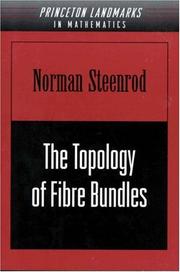
ISBN: 0691080550 0691005486 1400883873 9780691080550 Year: 1951 Volume: 14 Publisher: Princeton (N.J.) : Princeton university press,
Abstract | Keywords | Export | Availability | Bookmark
 Loading...
Loading...Choose an application
- Reference Manager
- EndNote
- RefWorks (Direct export to RefWorks)
Fibre bundles, now an integral part of differential geometry, are also of great importance in modern physics--such as in gauge theory. This book, a succinct introduction to the subject by renown mathematician Norman Steenrod, was the first to present the subject systematically. It begins with a general introduction to bundles, including such topics as differentiable manifolds and covering spaces. The author then provides brief surveys of advanced topics, such as homotopy theory and cohomology theory, before using them to study further properties of fibre bundles. The result is a classic and timeless work of great utility that will appeal to serious mathematicians and theoretical physicists alike.
#WWIS:d.d. Prof. L. Bouckaert/ALTO --- 515.1 --- 515.1 Topology --- Topology --- Topology. --- Analysis situs --- Position analysis --- Rubber-sheet geometry --- Geometry --- Polyhedra --- Set theory --- Algebras, Linear --- Algebraic topology. --- Associated bundle. --- Associative algebra. --- Associative property. --- Atlas (topology). --- Automorphism. --- Axiomatic system. --- Barycentric subdivision. --- Bilinear map. --- Bundle map. --- Classification theorem. --- Coefficient. --- Cohomology ring. --- Cohomology. --- Conjugacy class. --- Connected component (graph theory). --- Connected space. --- Coordinate system. --- Coset. --- Cup product. --- Cyclic group. --- Determinant. --- Differentiable manifold. --- Differential structure. --- Dimension (vector space). --- Direct product. --- Division algebra. --- Equivalence class. --- Equivalence relation. --- Euler number. --- Existence theorem. --- Existential quantification. --- Factorization. --- Fiber bundle. --- Frenet–Serret formulas. --- Gram–Schmidt process. --- Group theory. --- Homeomorphism. --- Homology (mathematics). --- Homomorphism. --- Homotopy group. --- Homotopy. --- Hopf theorem. --- Hurewicz theorem. --- Identity element. --- Inclusion map. --- Inner automorphism. --- Invariant subspace. --- Invertible matrix. --- Jacobian matrix and determinant. --- Klein bottle. --- Lattice of subgroups. --- Lie group. --- Line element. --- Line segment. --- Linear map. --- Linear space (geometry). --- Linear subspace. --- Manifold. --- Mapping cylinder. --- Metric tensor. --- N-sphere. --- Natural topology. --- Octonion. --- Open set. --- Orientability. --- Orthogonal group. --- Orthogonalization. --- Permutation. --- Principal bundle. --- Product topology. --- Quadratic form. --- Quaternion. --- Retract. --- Separable space. --- Set theory. --- Simplicial complex. --- Special case. --- Stiefel manifold. --- Subalgebra. --- Subbase. --- Subgroup. --- Subset. --- Symmetric tensor. --- Tangent bundle. --- Tangent space. --- Tangent vector. --- Tensor field. --- Tensor. --- Theorem. --- Tietze extension theorem. --- Topological group. --- Topological space. --- Transitive relation. --- Transpose. --- Union (set theory). --- Unit sphere. --- Universal bundle. --- Vector field.
Book
ISBN: 0691643024 1400853656 9781400853656 9781306988988 1306988985 0691082510 9780691615622 Year: 2014 Publisher: Princeton, NJ : Princeton University Press,
Abstract | Keywords | Export | Availability | Bookmark
 Loading...
Loading...Choose an application
- Reference Manager
- EndNote
- RefWorks (Direct export to RefWorks)
The purpose of this book is to provide a self-contained account, accessible to the non-specialist, of algebra necessary for the solution of the integrability problem for transitive pseudogroup structures.Originally published in 1981.The Princeton Legacy Library uses the latest print-on-demand technology to again make available previously out-of-print books from the distinguished backlist of Princeton University Press. These editions preserve the original texts of these important books while presenting them in durable paperback and hardcover editions. The goal of the Princeton Legacy Library is to vastly increase access to the rich scholarly heritage found in the thousands of books published by Princeton University Press since its founding in 1905.
Lie algebras. --- Ideals (Algebra) --- Pseudogroups. --- Global analysis (Mathematics) --- Lie groups --- Algebraic ideals --- Algebraic fields --- Rings (Algebra) --- Algebras, Lie --- Algebra, Abstract --- Algebras, Linear --- Lie algebras --- Pseudogroups --- 512.81 --- 512.81 Lie groups --- Ideals (Algebra). --- Lie, Algèbres de. --- Idéaux (algèbre) --- Pseudogroupes (mathématiques) --- Ordered algebraic structures --- Analytical spaces --- Addition. --- Adjoint representation. --- Algebra homomorphism. --- Algebra over a field. --- Algebraic extension. --- Algebraic structure. --- Analytic function. --- Associative algebra. --- Automorphism. --- Bilinear form. --- Bilinear map. --- Cartesian product. --- Closed graph theorem. --- Codimension. --- Coefficient. --- Cohomology. --- Commutative ring. --- Commutator. --- Compact space. --- Complex conjugate. --- Complexification (Lie group). --- Complexification. --- Conjecture. --- Constant term. --- Continuous function. --- Contradiction. --- Corollary. --- Counterexample. --- Diagram (category theory). --- Differentiable manifold. --- Differential form. --- Differential operator. --- Dimension (vector space). --- Dimension. --- Direct sum. --- Discrete space. --- Donald C. Spencer. --- Dual basis. --- Embedding. --- Epimorphism. --- Existential quantification. --- Exterior (topology). --- Exterior algebra. --- Exterior derivative. --- Faithful representation. --- Formal power series. --- Graded Lie algebra. --- Ground field. --- Homeomorphism. --- Homomorphism. --- Hyperplane. --- I0. --- Indeterminate (variable). --- Infinitesimal transformation. --- Injective function. --- Integer. --- Integral domain. --- Invariant subspace. --- Invariant theory. --- Isotropy. --- Jacobi identity. --- Levi decomposition. --- Lie algebra. --- Linear algebra. --- Linear map. --- Linear subspace. --- Local diffeomorphism. --- Mathematical induction. --- Maximal ideal. --- Module (mathematics). --- Monomorphism. --- Morphism. --- Natural transformation. --- Non-abelian. --- Partial differential equation. --- Pseudogroup. --- Pullback (category theory). --- Simple Lie group. --- Space form. --- Special case. --- Subalgebra. --- Submanifold. --- Subring. --- Summation. --- Symmetric algebra. --- Symplectic vector space. --- Telescoping series. --- Theorem. --- Topological algebra. --- Topological space. --- Topological vector space. --- Topology. --- Transitive relation. --- Triviality (mathematics). --- Unit vector. --- Universal enveloping algebra. --- Vector bundle. --- Vector field. --- Vector space. --- Weak topology. --- Lie, Algèbres de. --- Idéaux (algèbre) --- Pseudogroupes (mathématiques)
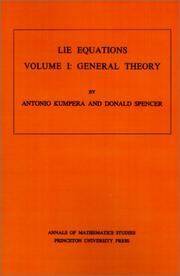
ISBN: 0691081115 9780691081113 1400881730 Year: 1972 Volume: 73 Publisher: Princeton, N.J.
Abstract | Keywords | Export | Availability | Bookmark
 Loading...
Loading...Choose an application
- Reference Manager
- EndNote
- RefWorks (Direct export to RefWorks)
In this monograph the authors redevelop the theory systematically using two different approaches. A general mechanism for the deformation of structures on manifolds was developed by Donald Spencer ten years ago. A new version of that theory, based on the differential calculus in the analytic spaces of Grothendieck, was recently given by B. Malgrange. The first approach adopts Malgrange's idea in defining jet sheaves and linear operators, although the brackets and the non-linear theory arc treated in an essentially different manner. The second approach is based on the theory of derivations, and its relationship to the first is clearly explained. The introduction describes examples of Lie equations and known integrability theorems, and gives applications of the theory to be developed in the following chapters and in the subsequent volume.
Differential geometry. Global analysis --- Lie groups --- Lie algebras --- Differential equations --- Groupes de Lie --- Algèbres de Lie --- Equations différentielles --- 514.76 --- Groups, Lie --- Symmetric spaces --- Topological groups --- Algebras, Lie --- Algebra, Abstract --- Algebras, Linear --- Equations, Differential --- Bessel functions --- Calculus --- Geometry of differentiable manifolds and of their submanifolds --- Differential equations. --- Lie algebras. --- Lie groups. --- 517.91 Differential equations --- 514.76 Geometry of differentiable manifolds and of their submanifolds --- Algèbres de Lie --- Equations différentielles --- 517.91. --- Numerical solutions --- Surfaces, Deformation of --- Surfaces (mathématiques) --- Déformation --- Pseudogroups. --- Pseudogroupes (mathématiques) --- 517.91 --- Adjoint representation. --- Adjoint. --- Affine transformation. --- Alexander Grothendieck. --- Analytic function. --- Associative algebra. --- Atlas (topology). --- Automorphism. --- Bernhard Riemann. --- Big O notation. --- Bundle map. --- Category of topological spaces. --- Cauchy–Riemann equations. --- Coefficient. --- Commutative diagram. --- Commutator. --- Complex conjugate. --- Complex group. --- Complex manifold. --- Computation. --- Conformal map. --- Continuous function. --- Coordinate system. --- Corollary. --- Cotangent bundle. --- Curvature tensor. --- Deformation theory. --- Derivative. --- Diagonal. --- Diffeomorphism. --- Differentiable function. --- Differential form. --- Differential operator. --- Differential structure. --- Direct proof. --- Direct sum. --- Ellipse. --- Endomorphism. --- Equation. --- Exact sequence. --- Exactness. --- Existential quantification. --- Exponential function. --- Exponential map (Riemannian geometry). --- Exterior derivative. --- Fiber bundle. --- Fibration. --- Frame bundle. --- Frobenius theorem (differential topology). --- Frobenius theorem (real division algebras). --- Group isomorphism. --- Groupoid. --- Holomorphic function. --- Homeomorphism. --- Integer. --- J-invariant. --- Jacobian matrix and determinant. --- Jet bundle. --- Linear combination. --- Linear map. --- Manifold. --- Maximal ideal. --- Model category. --- Morphism. --- Nonlinear system. --- Open set. --- Parameter. --- Partial derivative. --- Partial differential equation. --- Pointwise. --- Presheaf (category theory). --- Pseudo-differential operator. --- Pseudogroup. --- Quantity. --- Regular map (graph theory). --- Requirement. --- Riemann surface. --- Right inverse. --- Scalar multiplication. --- Sheaf (mathematics). --- Special case. --- Structure tensor. --- Subalgebra. --- Subcategory. --- Subgroup. --- Submanifold. --- Subset. --- Tangent bundle. --- Tangent space. --- Tangent vector. --- Tensor field. --- Tensor product. --- Theorem. --- Torsion tensor. --- Transpose. --- Variable (mathematics). --- Vector bundle. --- Vector field. --- Vector space. --- Volume element. --- Surfaces (mathématiques) --- Déformation --- Analyse sur une variété
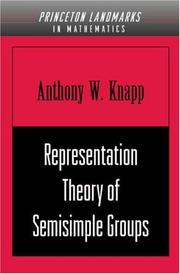
ISBN: 0691090890 9780691090894 0691084017 1400883970 9780691084015 Year: 1986 Volume: 36 Publisher: Princeton (N.J.) : Princeton university press,
Abstract | Keywords | Export | Availability | Bookmark
 Loading...
Loading...Choose an application
- Reference Manager
- EndNote
- RefWorks (Direct export to RefWorks)
In this classic work, Anthony W. Knapp offers a survey of representation theory of semisimple Lie groups in a way that reflects the spirit of the subject and corresponds to the natural learning process. This book is a model of exposition and an invaluable resource for both graduate students and researchers. Although theorems are always stated precisely, many illustrative examples or classes of examples are given. To support this unique approach, the author includes for the reader a useful 300-item bibliography and an extensive section of notes.
Semisimple Lie groups. --- Representations of groups. --- Groupes de Lie semi-simples --- Représentations de groupes --- Semisimple Lie groups --- Representations of groups --- Semi-simple Lie groups --- Lie groups --- Group representation (Mathematics) --- Groups, Representation theory of --- Group theory --- Représentations de groupes --- 512.547 --- 512.547 Linear representations of abstract groups. Group characters --- Linear representations of abstract groups. Group characters --- Abelian group. --- Admissible representation. --- Algebra homomorphism. --- Analytic function. --- Analytic proof. --- Associative algebra. --- Asymptotic expansion. --- Automorphic form. --- Automorphism. --- Bounded operator. --- Bounded set (topological vector space). --- Cartan subalgebra. --- Cartan subgroup. --- Category theory. --- Characterization (mathematics). --- Classification theorem. --- Cohomology. --- Complex conjugate representation. --- Complexification (Lie group). --- Complexification. --- Conjugate transpose. --- Continuous function (set theory). --- Degenerate bilinear form. --- Diagram (category theory). --- Dimension (vector space). --- Dirac operator. --- Discrete series representation. --- Distribution (mathematics). --- Eigenfunction. --- Eigenvalues and eigenvectors. --- Existence theorem. --- Explicit formulae (L-function). --- Fourier inversion theorem. --- General linear group. --- Group homomorphism. --- Haar measure. --- Heine–Borel theorem. --- Hermitian matrix. --- Hilbert space. --- Holomorphic function. --- Hyperbolic function. --- Identity (mathematics). --- Induced representation. --- Infinitesimal character. --- Integration by parts. --- Invariant subspace. --- Invertible matrix. --- Irreducible representation. --- Jacobian matrix and determinant. --- K-finite. --- Levi decomposition. --- Lie algebra. --- Locally integrable function. --- Mathematical induction. --- Matrix coefficient. --- Matrix group. --- Maximal compact subgroup. --- Meromorphic function. --- Metric space. --- Nilpotent Lie algebra. --- Norm (mathematics). --- Parity (mathematics). --- Plancherel theorem. --- Projection (linear algebra). --- Quantifier (logic). --- Reductive group. --- Representation of a Lie group. --- Representation theory. --- Schwartz space. --- Semisimple Lie algebra. --- Set (mathematics). --- Sign (mathematics). --- Solvable Lie algebra. --- Special case. --- Special linear group. --- Special unitary group. --- Subgroup. --- Summation. --- Support (mathematics). --- Symmetric algebra. --- Symmetrization. --- Symplectic group. --- Tensor algebra. --- Tensor product. --- Theorem. --- Topological group. --- Topological space. --- Topological vector space. --- Unitary group. --- Unitary matrix. --- Unitary representation. --- Universal enveloping algebra. --- Variable (mathematics). --- Vector bundle. --- Weight (representation theory). --- Weyl character formula. --- Weyl group. --- Weyl's theorem. --- ZPP (complexity). --- Zorn's lemma.
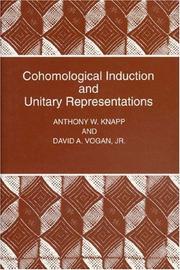
ISBN: 0691037566 1400883938 Year: 1995 Publisher: Princeton : Princeton University Press,
Abstract | Keywords | Export | Availability | Bookmark
 Loading...
Loading...Choose an application
- Reference Manager
- EndNote
- RefWorks (Direct export to RefWorks)
This book offers a systematic treatment--the first in book form--of the development and use of cohomological induction to construct unitary representations. George Mackey introduced induction in 1950 as a real analysis construction for passing from a unitary representation of a closed subgroup of a locally compact group to a unitary representation of the whole group. Later a parallel construction using complex analysis and its associated co-homology theories grew up as a result of work by Borel, Weil, Harish-Chandra, Bott, Langlands, Kostant, and Schmid. Cohomological induction, introduced by Zuckerman, is an algebraic analog that is technically more manageable than the complex-analysis construction and leads to a large repertory of irreducible unitary representations of reductive Lie groups. The book, which is accessible to students beyond the first year of graduate school, will interest mathematicians and physicists who want to learn about and take advantage of the algebraic side of the representation theory of Lie groups. Cohomological Induction and Unitary Representations develops the necessary background in representation theory and includes an introductory chapter of motivation, a thorough treatment of the "translation principle," and four appendices on algebra and analysis.
512.73 --- Harmonic analysis --- Homology theory --- Representations of groups --- Semisimple Lie groups --- Semi-simple Lie groups --- Lie groups --- Group representation (Mathematics) --- Groups, Representation theory of --- Group theory --- Cohomology theory --- Contrahomology theory --- Algebraic topology --- Analysis (Mathematics) --- Functions, Potential --- Potential functions --- Banach algebras --- Calculus --- Mathematical analysis --- Mathematics --- Bessel functions --- Fourier series --- Harmonic functions --- Time-series analysis --- Cohomology theory of algebraic varieties and schemes --- 512.73 Cohomology theory of algebraic varieties and schemes --- Lie algebras. --- Lie, Algèbres de. --- Semisimple Lie groups. --- Representations of groups. --- Homology theory. --- Harmonic analysis. --- Représentations d'algèbres de Lie --- Representations of Lie algebras --- Abelian category. --- Additive identity. --- Adjoint representation. --- Algebra homomorphism. --- Associative algebra. --- Associative property. --- Automorphic form. --- Automorphism. --- Banach space. --- Basis (linear algebra). --- Bilinear form. --- Cartan pair. --- Cartan subalgebra. --- Cartan subgroup. --- Cayley transform. --- Character theory. --- Classification theorem. --- Cohomology. --- Commutative property. --- Complexification (Lie group). --- Composition series. --- Conjugacy class. --- Conjugate transpose. --- Diagram (category theory). --- Dimension (vector space). --- Dirac delta function. --- Discrete series representation. --- Dolbeault cohomology. --- Eigenvalues and eigenvectors. --- Explicit formulae (L-function). --- Fubini's theorem. --- Functor. --- Gregg Zuckerman. --- Grothendieck group. --- Grothendieck spectral sequence. --- Haar measure. --- Hecke algebra. --- Hermite polynomials. --- Hermitian matrix. --- Hilbert space. --- Hilbert's basis theorem. --- Holomorphic function. --- Hopf algebra. --- Identity component. --- Induced representation. --- Infinitesimal character. --- Inner product space. --- Invariant subspace. --- Invariant theory. --- Inverse limit. --- Irreducible representation. --- Isomorphism class. --- Langlands classification. --- Langlands decomposition. --- Lexicographical order. --- Lie algebra. --- Linear extension. --- Linear independence. --- Mathematical induction. --- Matrix group. --- Module (mathematics). --- Monomial. --- Noetherian. --- Orthogonal transformation. --- Parabolic induction. --- Penrose transform. --- Projection (linear algebra). --- Reductive group. --- Representation theory. --- Semidirect product. --- Semisimple Lie algebra. --- Sesquilinear form. --- Sheaf cohomology. --- Skew-symmetric matrix. --- Special case. --- Spectral sequence. --- Stein manifold. --- Sub"ient. --- Subalgebra. --- Subcategory. --- Subgroup. --- Submanifold. --- Summation. --- Symmetric algebra. --- Symmetric space. --- Symmetrization. --- Tensor product. --- Theorem. --- Uniqueness theorem. --- Unitary group. --- Unitary operator. --- Unitary representation. --- Upper and lower bounds. --- Verma module. --- Weight (representation theory). --- Weyl character formula. --- Weyl group. --- Weyl's theorem. --- Zorn's lemma. --- Zuckerman functor. --- Lie, Algèbres de. --- Représentations d'algèbres de Lie
| Listing 1 - 7 of 7 |
Sort by
|

 Search
Search Feedback
Feedback About UniCat
About UniCat  Help
Help News
News